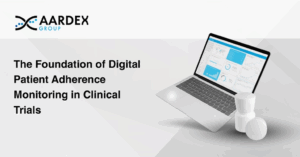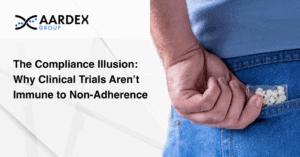Despite huge strides in how cardiovascular diseases (CVD) are treated in recent years, the conditions remain among the leading causes of morbidity and mortality worldwide.
At least part of the problem is that even the most effective drugs will not work if people do not take them. Yet both in routine practice and in clinical trials, poor medication adherence is a problem that continues to hamper progress against these deadly diseases.
In this article, Bernard Vrijens, our Scientific Lead explains how and why medicine-taking behavior matters in cardiology, and what healthcare professionals and researchers alike can do to take treatment and care to the next level.
The CVD Epidemic
We are in the midst of a CVD epidemic. The conditions are the leading cause of mortality worldwide, taking 17.9 million lives annually, and accounting for 32% of all deaths. Of these, around 85% can be attributed to strokes and heart attacks which are, in the main part, preventable.1
And while more than 75% of CVD deaths occur in low- and middle-income countries,1 the problem is in no way confined to the developing world. In the United States, around 659,000 deaths – or one in four2 – are attributed to heart disease, while in the EU, the CVD death toll is a 1.8million.3
These startling figures are despite the emergence of highly effective, evidence-backed drugs for the primary and secondary prevention of CVDs, such as statins and angiotensin-converting-enzyme (ACE) inhibitors, in recent years.
The problem, then, is not a lack of efficacious pharmacological interventions. Rather a lack of medication adherence is a significant obstacle in the fight against heart disease.
Speaking as part of a Novartis video series, Dr Steven Nissen, researcher, patient advocate, and chairman of cardiovascular medicine at the Cleveland Clinic, said: “We have powerful drugs, but they don’t work if you don’t take them…the problem is adherence.”4
The Medication Adherence Problem
Poor adherence to medication is a problem across diseases and therapy areas. In routine practice, it is associated with 125,000 deaths and $310billion of costs every year in the US, and 194,000 deaths and €125billion of costs in Europe. In addition, it accounts for between 33% and 69% of all medication-related hospital admissions in the US.5
Adherence to CVD medications leads to better outcomes. A review published in 2018 referenced a cohort study of 59,000 new statin users in the Netherlands that found at least two years of adherence was associated with a 30% reduction in the risk of being hospitalized with acute myocardial infarction. Another, of more than 29,000 patients, reported a direct association between survival and adherence to statin therapy. Despite this, approximately 50% of patients with CVD and/or its major risk factors demonstrate poor adherence to their prescribed medicines, said the authors.6
When it comes to clinical trials, one-third of phase III participants are non-adherent by day 100 7 and, across all development stages, 50% admit to not following the dosing protocol.8 With each clinical trial participant being responsible for of $42,0007 in costs and the average cardiology study enrolling thousands of patients, the impact is hugely significant. It can lead to underestimations of drug efficacy, unexpected adverse events, and drain study power, even to the point of study failure.
While the factors that lead to poor medication adherence are complex, multifaceted, and individual, they broadly fit into two categories: intentional, which is largely associated with patient motivation, and unintentional, which tends to be driven by a lack of capacity or resources to take medications.
In addition, adherence is not fixed. People with chronic conditions, for example, tend to take their medicines as prescribed for the first six months, after which adherence often drops steeply.9
Again, the reasons are complex, but, in CVDs, can often be attributed to the “silent” nature of the conditions – someone taking a statin or ACE inhibiter to prevent disease progression or to treat invisible symptoms may not necessarily see or feel the benefit, so can lose motivation to continue on the drug, for example.
Dr Nissen said: “High cholesterol doesn’t make you feel sick or bad, so people say: ‘I feel okay, I’ll stop the drugs’.” This non-adherence, he went on, can have terrible consequences.5
It leads to shortfalls in drug exposure that can result in rates of blood pressure control and highly variable responses to treatment.10
Holistic Measurement
In 2018, the Non-adherence Academic Research Consortium (NARC) recognized the importance of collecting adherence data during clinical trials.5
“Imprecision in assessing and classifying non-adherence, and the lack of a consistent approach to incorporating adherence data in the analysis of study results, may lead to imprecision in the calculated perceived efficacy of a drug in clinical trials,” the group said in its consensus report, Standardized Classification and Framework For Reporting, Interpreting, and Analysing Medication Non-Adherence in Cardiovascular Clinical Trials.
“Thus, many trials may not accurately answer the question posed by the sponsors and regulators, who seek an accurate estimate of the true efficacy of treatment, or the question posed by payers who seek a reliable estimate of the effectiveness of treatment in the marketplace after approval.”
Researchers, NARC recommended, should be looking for methods that capture the type of non-adherence, the non-adherence decision-maker (i.e. was the non-adherence medically or patient-driven), the reasons, and the timing. This holistic view of the data will give teams a 360°-degree view of the investigational product, from development to post-marketing, they argue.
This detail of measurement, however, is extremely challenging using traditional methods. Counting returned tablets, for example, is easily censored by participants, while monitoring drug or drug metabolites in blood, urine, or hair can give rise to “white coat adherence”, meaning people only take the drug the day before their site visit. Meanwhile, self-, site- or HCP-report are all vulnerable to inaccuracies and bias that can generate incomplete or inaccurate data. Overall, these approaches only provide a snapshot of adherence between site visits, rather than the four tiers of information recommended by NARC.
Digital Future
Digital monitoring that combines smart packaging with powerful data analytics is different in that it is objective, precise, and provides a holistic view of medication-taking behavior.
Microcirculatory in the packaging records dose administration and transmits the information to the study team or HCP. A cloud-based platform then uses sophisticated algorithms to analyze medication-taking behavior, and flags erratic dosing patterns for further investigation.
By identifying participants who may be at risk of poor adherence, it enables sites and HCP to tailor actions that address individuals’ personal non-adherence drivers and ensure that all the relevant data are collected in real-time.
Crucially, it is evidence-based. Studies have shown that smart package monitoring is 97% accurate, compared to 60% for pill counting, 50% for healthcare professional rating, and 27% for self-report.11
Heart of the Matter
The CVD epidemic continues at pace, despite the medical community having access to highly efficacious medicines. At least part of the problem is the high levels of non-adherence that start in clinical trials and continue into routine practice.
Improving adherence starts with understanding adherence – and that can only be achieved with the holistic, accurate measurement that connected packaging and data analytics makes possible.
References
- World Health Organization. Cardiovascular diseases. (n.d.) Available at: https://www.who.int/health-topics/cardiovascular-diseases#tab=tab_1
- Centers for Disease Control. Heart disease facts. (2022). Available at: https://www.cdc.gov/heartdisease/facts.htm#:~:text=Heart%20Disease%20in%20the%20United%20States&text=One%20person%20dies%20every%2036,United%20States%20from%20cardiovascular%20disease.&text=About%20659%2C000%20people%20in%20the,1%20in%20every%204%20deaths. Last accessed: 20th April 2022
- European Heart Network. European Cardiovascular Disease Statistics 2017. (2017). Available at: https://ehnheart.org/cvd-statistics.html#:~:text=Each%20year%20cardiovascular%20disease%20(CVD,all%20deaths%20in%20the%20EU. Last accessed: 20th April 2022
- Valgimigli, M., Garcia-Garcia, H. M., Vrijens, B., Vranckx, P., McFadden, E. P., Costa, F., … & Tijssen, J. G. (2019). Standardized classification and framework for reporting, interpreting, and analyzing medication non-adherence in cardiovascular clinical trials: a consensus report from the Non-adherence Academic Research Consortium (NARC). European Heart Journal, 40(25), 2070-2085.
- John Tsai. Home [LinkedIn page] Retrieved May 5, 2022, from https://www.linkedin.com/feed/update/urn:li:activity:6909501556614651904/
- Lansberg, P., Lee, A., Lee, Z. V., Subramaniam, K., & Setia, S. (2018). Nonadherence to statins: individualized intervention strategies outside the pill box. Vascular Health And Risk Management, 14, 91.
- Fogel, D. B. (2018). Factors associated with clinical trials that fail and opportunities for improving the likelihood of success: a review. Contemporary Clinical Trials Communications, 11, 156-164.
- Hwang, T. J., Carpenter, D., Lauffenburger, J. C., Wang, B., Franklin, J. M., & Kesselheim, A. S. (2016). Failure of investigational drugs in late-stage clinical development and publication of trial results. JAMA Internal Medicine, 176(12), 1826-1833.
- Bartholomew, T., Naci, H., Robertson, E., & Schmidt, H. (2022). Use of adherence monitoring in drug contracts tied to outcomes: put patients first. BMJ, 376.
- Vrijens, B., Vincze, G., Kristanto, P., Urquhart, J., & Burnier, M. (2008). Adherence to prescribed antihypertensive drug treatments: longitudinal study of electronically compiled dosing histories. BMJ,, 336(7653), 1114-1117.
- El Alili, M., Vrijens, B., Demonceau, J., Evers, S. M., & Hiligsmann, M. (2016). A scoping review of studies comparing the medication event monitoring system (MEMS) with alternative methods for measuring medication adherence. British Journal Of Clinical Pharmacology, 82(1), 268-279.



